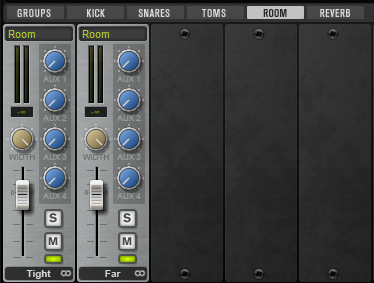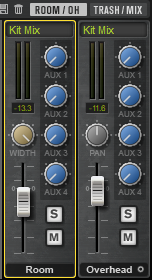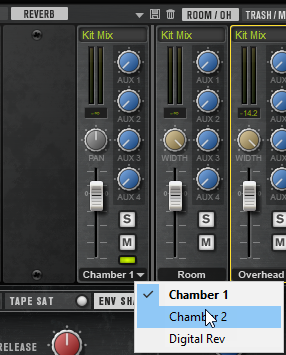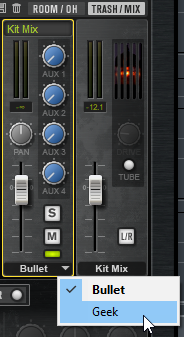Mixer Page Parameters
As for other Acoustic Agent kits, the Agent mixer provides dedicated channels for all instrument groups as well as for the individual instruments.
Room Microphones

On the Room tab, you can make individual settings for the two room microphone channels. The two channels can be used at the same time or individually.
-
Tight is a set of uncompressed condenser microphones positioned close to the kit, which capture the overall sound of the kit as well as a portion of the room.
-
Far is a set of uncompressed condenser microphones positioned farther away from the kit, which capture all room ambiance.
You can switch between mono ![]() and stereo
and stereo ![]() by clicking on the right of the channel name at the bottom of the channel strip.
by clicking on the right of the channel name at the bottom of the channel strip.
On the Room/OH tab in the right section of the mixer, you find the room master channel that allows further adjustments for the mixed room signals.

Reverb

In addition to the real room microphones, you can use one of three additional reverb signals to enriched the sound of the instruments.
-
For Chamber 1 and Chamber 2, the sound was sent to and recorded in different echo chambers.
-
For Digital Rev, the sound was sent to a classical digital reverb processor and the effect signal was recorded.
Overhead
The overhead channel on the Room/OH tab comes with a mono and a stereo version.
You can switch between mono ![]() and stereo
and stereo ![]() by clicking on the right of the channel name at the bottom of the channel strip.
by clicking on the right of the channel name at the bottom of the channel strip.
Trash
The trash microphone channel on the Trash/Mix tab allows you to add one of two single overly compressed microphones. These microphones were mounted just above the kick and below the toms, pointed at the drummer. The signal can be blended into the mix to add energy or grit to it.
You can choose between two types: Bullet, which is a harmonica microphone and lets you add a lofi, crunchy sound, and Geek, which has a wider frequency range and adds a very distorted sound.

RAM Usage and Voices

The room channels, the reverb channel, and the trash mic channel can be deactivated by clicking the corresponding Deactivate Microphone Channel button. This unloads all samples of the channel from RAM, which reduces the amount of required memory and the number of samples that are played simultaneously.